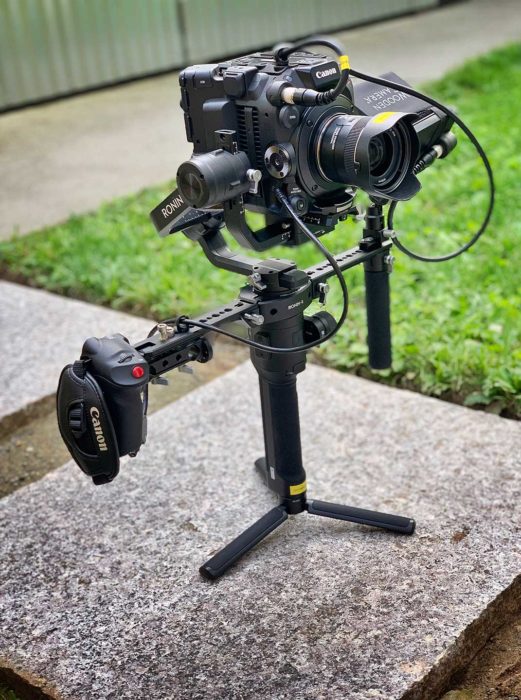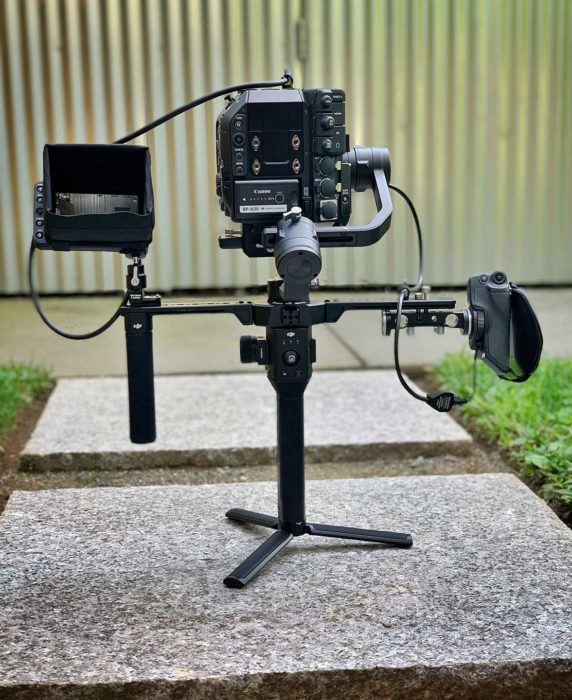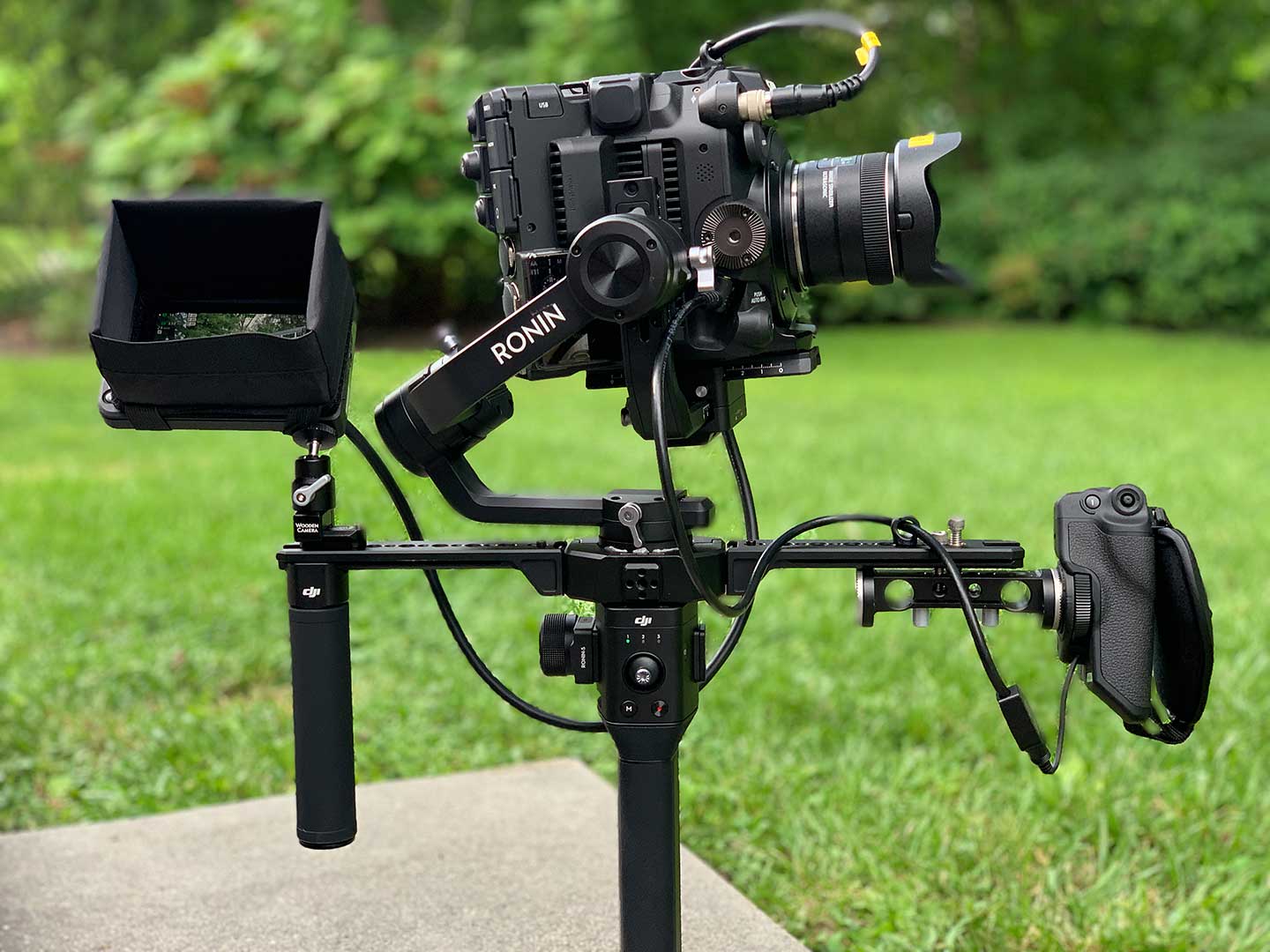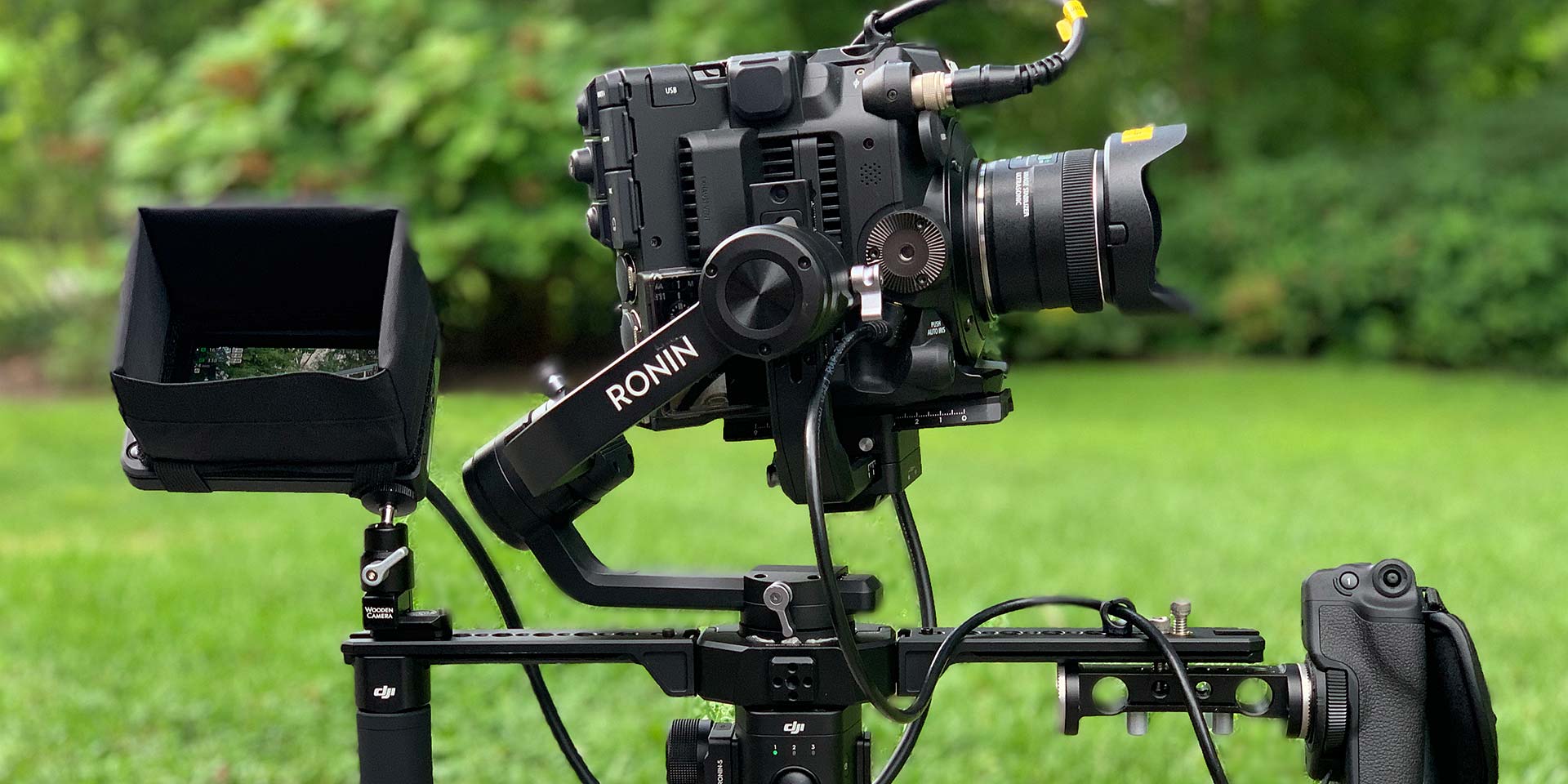
I have been meaning to try my Canon C500 Mark II on my DJI Ronin-S gimbal for some time. Others have done it, so it’s definitely feasible – the gimbal can support the weight, but I wanted to see for myself if it had the promise to not only be usable but to also be practical.
The quick answer is yes but with caveats. It works and if you are looking for smooth footage it is better than what you can achieve in many other configurations short of going to a larger gimbal but the gimbal, camera, and accessories are heavy. They total ~10 lb. and to make it work you’ll need to limit the size and weight of the lens you use, you’ll need to use Canon’s smaller BP-A30 battery, and I’d advise using DJI’s Accessory Handles for the Ronin-S.
The Ronin-S has a weight capacity of 7.94 lb. and a bare C500 Mark II weighs 3.9 lb. Add a Canon BP-A30 battery (8 oz.), a Canon EF 24mm f/2.8 IS USM lens (~10 oz), and you are at just under 5 lb. Keep in mind the grip needs to be removed from the camera as well as the monitor and if you are using them the top plate and the handle. The monitor and the grip can be mounted to the Ronin-S’ accessory handles.

The gimbal itself weighs 4.1 pounds. So, all told you end up at that 10 lb. mark once the kit is configured.
It is a significant amount of weight but if you are strong enough it is certainly fine for a number of takes. How many will be up to the user but anything beyond their limit and they’ll want a vest-based mounting setup or better yet a full-size gimbal.
I ran a series of tests with the setup as described, the C500 Mark II on the Ronin-S. These run the same course as when I was tested the Ronin-S in various configurations in 2019.
Test 1
Canon C500 Mark II on a Ronin-S Test 1 on YouTube.
This test runs along a paved path up two steps, then up four more, turns around and returns along the same route.
The test is filmed with the camera on the gimbal and the lens’ IS on, with the lens IS off, with the camera handheld (no gimbal) but with camera EIS and lens IS on, and then handheld with no added IS or EIS. There are also two follow-up tests where IS has been added in post in FCP X.
Test 2
Canon C500 Mark II on a Ronin-S Test 2 on YouTube.
This test runs across gravel, along a slightly sloped lawn, around a tree and then back to the gravel. There are a number of twists and turns.
Similar to Test 1, Test 2 follows the same configurations. The route is filmed with the camera on the gimbal and the lens’ IS on, with the lens IS off, with the camera handheld (no gimbal) but with camera EIS and lens IS on, and then handheld with no added IS or EIS. There are also two follow-up tests where IS has been added in post in FCP X.
Test 3
Canon C500 Mark II on a Ronin-S: Test 3 – Tilt and Rise/Fall on YouTube.
This test is from a stationary stance and it tilts the camera up and down via the gimbal. It then uses the lock mode to hold the camera level and completes some rises and falls. Each test is done in two configurations with the lens’ IS on and with it off.
Conclusion
My take away from the testing is that it can be done and the footage can look very nice. In some cases lens IS turned on helped, in others it did not make a difference nor did it hurt the footage. So, it makes sense to leave lens IS on if you are using an image stabilized lens.
The Ronin-S motors did not appear to be overly strained in any of the tests. They worked as smoothly as when a smaller camera is used on the gimbal. The setup itself was very solid and did not feel janky in the least.
I mentioned earlier that I used Canon’s EF 24mm f/2.8 IS USM lens, a small and lightweight lens that is ~10 oz. in weight and ~2 inches in length. You will need to use a similarly sized lens or smaller to make the C500 Mark II work on the Ronin-S. *A larger lens like a Canon EF 35mm f/2.8L II USM, ~1.7 lb. and ~4″ in length, will not work. It causes the camera to be further back when balanced and that leaves virtually no room for the camera to move on the tilt axis of the gimbal. I suspect that Canon’s EF 35mm f/2.8 IS USM, EF 50mm f/1.4 or f/1.8 USM, EF 35mm f/2.0 IS USM, and EF 40mm f/2.8 STM pancake lenses would all work fine.

For me the Ronin-S’ accessory handles are necessary to the setup. They distribute the weight of the gimbal and their wider stance provides the operator with more finesse and control over the gimbal’s movements. The handles also provide mounting points for the monitor and the camera’s grip. You’ll need to figure out a way to get an Arri rosette mounted for the grip. I used a 15mm rod brace I happened to have but there are other options which may work better. If you connect the grip to the camera with an extension cable you can take advantage of the grip’s start/stop record button and its aperture control dial.
In the second part of Test 3, the rise and fall movement, my attempt at completing it with the lens’ IS turned off is a bit jerky. To do this test I had to to have my right hand on the gimbal’s center column and my left on the accessory handle. Just that change, moving my hands in closer together, makes the setup that much harder to operate. To go further and not use the gimbal’s accessory handles at all would be harder still.
I mounted the camera monitor off to the side. To do the same you’ll need Canon’s expensive 39″ UN-10 cable though you could use any monitor tied in via HDMI or SDI.

As far as my original question goes – is it practical? On a certain level it is. It works as you can see in the tests, the build is solid, and the gimbal’s motors are not stressed. You are limited on lens selection but if you can work within those constraints it can work well for a limited number of takes.
The weight will always be a factor. I found that on certain shots my left-right drift is worse with this setup than it is with a smaller camera on the same gimbal. You can see that in this next video where I chase my dog around. Some of the shots are fine but the second clip in particular has that drift.
Canon C500 Mark II on a Ronin-S Test 4 on YouTube.
If you need longer takes, a high quantity of multiple takes, a heavier lens or cinema glass, extras like a wireless FIZ control, etc. then you’ll need full-size professional gimbal and a mounting kit (vest and/or Steadicam arm). If you need to grab a few gimbal shots on a budget where the lower end glass is not a factor then this can work. As with all things gimbal leave time for the balancing and tuning. Don’t expect to whip the camera on and off the gimbal as needed especially if working under the pressure of an assignment.
—
*One note regarding bigger lenses and the camera/gimbal combo. There may be a way to add some counterbalance weight to the back of the camera thus enabling you to use a heavier lens on the front. At that point though you are most likely exceeding the weight capacity of the Ronin-S not to mention that of most operators.
